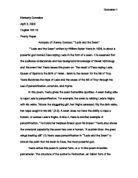Discuss the way Yeats explores the theme of destruction in "Leda and the Swan".
Discuss the ways Yeats explores the theme of destruction in Leda and The Swan
“Leda and the Swan”, written in 1923 yet published in 1928 as part of “The Tower” collection by Yeats, illustrates the brutal act of rape. According to Greek mythology, Zeus – the ruler of the Olympus – descends to Earth in the form of a swan and rapes Leda – the queen of Sparta. Yeats represents Zeus to be deceptive and there is a sense of duality because he is committing a sin whilst being a god and a swan, which are both majestic beings. However, near the end of the poem Yeats considers what has been created from the destruction; the most beautiful woman ever to set foot in Greek history. Hence, Yeats ponders if this immoral act was truly destructive.
The true destructive nature of the poem is presented via the detailed description of the swan’s dominance over Leda’s vulnerability and this is shown through a variety of phrases, “Above the staggering girl”, “dark webs” and “Nape caught in his bill”. As the swan is seen to be “above” Leda is suggests a sense of complete dominance over her and undermines Leda. Also, as she is “staggering” it shows that she not in control of herself anymore which emphasises her weakness. Moreover, the dominance is expressed through the fact that Leda is displayed to be trapped by the swan. The “dark webs” and “[her] nape caught” show that Leda is under full mercy of the swan. A web is a trap set by a spider, classed as a menacing creature, in order to devour its prey hence suggesting that there is no escape for Leda. Also, “dark webs” can depict the webbed feet of the swan which carry a connotation of entrapment because they are all joined with no gaps to escape. The “dark” colour alludes to a lack of hope as it obstructs all light from around the victim. Critics interpret “Leda and the Swan” to be an “allegory for the “rape” of Ireland by its colonial master” hence epitomising destructing and portraying it on a greater scale. Likewise, the “nape” is the part of the body where the spine meets the brain, both these components are vital to life thus, the swan holding her by her nape indicates her life is under the swan’s authority. Additionally, the lexical choice of powerlessness, “helpless”, “sudden”, “terrified” and “staggering” accentuate the destruction due to her being so exposed. “Helpless” and “terrified” combine fear with shock hence depicting imminent destruction through the act of rape because Leda has no way of reacting. In addition, destruction of rape is epitomised by deception; the swan, being such a majestic creature is now being considered to the harbinger of doom for Leda. The “feathered glory” of the swan creates a stark contrast to such an act and hence emphasises the sense of negativity of rape. Similarly, the idea of destruction through dominance is seen in “Easter 1916” due to the dominance of the English army over Ireland and causing havoc and damage to the city. This can be seen by the statement “needless death after all? // For England may keep faith”. The idea of the sheer catastrophe of death under the oppression of England is a reflection of Leda’s innocence being lost due to the swan. Additionally, the fact that “England may keep faith” depicts how they are unfazed by such an event and that their deed is done. Also, deception is also seen in “The Stolen Child” as the faeries are considered to be ethereal and beautiful yet are changelings who are there to steal children away and take them to a land of entrapment and intoxication. This is seen by the kinaesthetic imagery of the “flapping herons” as they create an atmosphere of paranoia and perhaps suggest an attempt to flee. The panic movement is seen in “Leda and the Swan” as Leda “[staggers]” in an attempt to flee yet she loses control.








